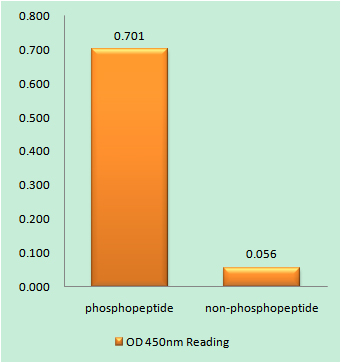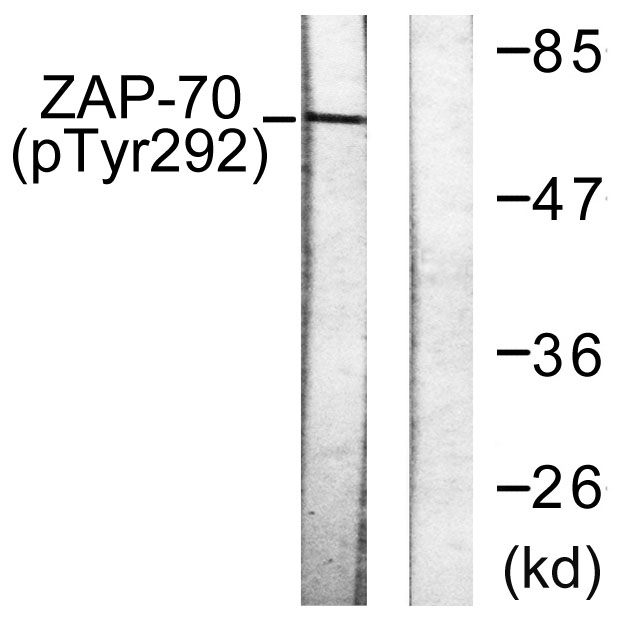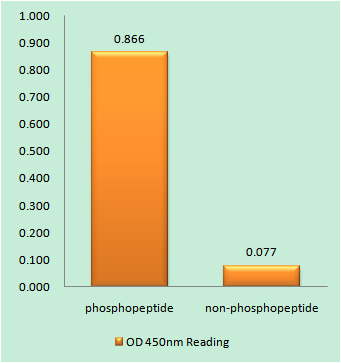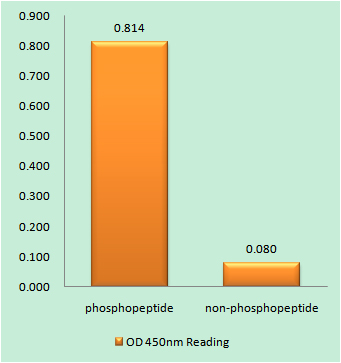
Catalog: YP0682
Size
Price
Status
Qty.
200μL
$600.00
In stock
0
100μL
$340.00
In stock
0
50μL
$190.00
In stock
0
Add to cart


Collected


Collect
Main Information
Target
ZAP-70
Host Species
Rabbit
Reactivity
Human, Mouse
Applications
WB, IHC, IF, ELISA
MW
60kD (Observed)
Conjugate/Modification
Phospho
Detailed Information
Recommended Dilution Ratio
WB 1:500-1:2000; IHC 1:100-1:300; ELISA 1:10000; IF 1:50-200
Formulation
Liquid in PBS containing 50% glycerol, 0.5% BSA and 0.02% sodium azide.
Specificity
Phospho-ZAP-70 (Y315) Polyclonal Antibody detects endogenous levels of ZAP-70 protein only when phosphorylated at Y315.The name of modified sites may be influenced by many factors, such as species (the modified site was not originally found in human samples) and the change of protein sequence (the previous protein sequence is incomplete, and the protein sequence may be prolonged with the development of protein sequencing technology). When naming, we will use the "numbers" in historical reference to keep the sites consistent with the reports. The antibody binds to the following modification sequence (lowercase letters are modification sites):SVyES
Purification
The antibody was affinity-purified from rabbit antiserum by affinity-chromatography using epitope-specific immunogen.
Storage
-15°C to -25°C/1 year(Do not lower than -25°C)
Concentration
1 mg/ml
MW(Observed)
60kD
Modification
Phospho
Clonality
Polyclonal
Isotype
IgG
Related Products
Antigen&Target Information
Immunogen:
The antiserum was produced against synthesized peptide derived from human ZAP-70 around the phosphorylation site of Tyr315. AA range:281-330
show all
Specificity:
Phospho-ZAP-70 (Y315) Polyclonal Antibody detects endogenous levels of ZAP-70 protein only when phosphorylated at Y315.The name of modified sites may be influenced by many factors, such as species (the modified site was not originally found in human samples) and the change of protein sequence (the previous protein sequence is incomplete, and the protein sequence may be prolonged with the development of protein sequencing technology). When naming, we will use the "numbers" in historical reference to keep the sites consistent with the reports. The antibody binds to the following modification sequence (lowercase letters are modification sites):SVyES
show all
Gene Name:
ZAP70
show all
Protein Name:
Tyrosine-protein kinase ZAP-70
show all
Other Name:
ZAP70 ;
SRK ;
Tyrosine-protein kinase ZAP-70 ;
70 kDa zeta-chain associated protein ;
Syk-related tyrosine kinase
SRK ;
Tyrosine-protein kinase ZAP-70 ;
70 kDa zeta-chain associated protein ;
Syk-related tyrosine kinase
show all
Background:
This gene encodes an enzyme belonging to the protein tyrosine kinase family, and it plays a role in T-cell development and lymphocyte activation. This enzyme, which is phosphorylated on tyrosine residues upon T-cell antigen receptor (TCR) stimulation, functions in the initial step of TCR-mediated signal transduction in combination with the Src family kinases, Lck and Fyn. This enzyme is also essential for thymocyte development. Mutations in this gene cause selective T-cell defect, a severe combined immunodeficiency disease characterized by a selective absence of CD8-positive T-cells. Two transcript variants that encode different isoforms have been found for this gene. [provided by RefSeq, Jul 2008],
show all
Function:
Catalytic activity:ATP + a [protein]-L-tyrosine = ADP + a [protein]-L-tyrosine phosphate.,Disease:Defects in ZAP70 are the cause of selective T-cell defect (STD) [MIM:176947]. STD is an autosomal recessive form of severe combined immunodeficiency characterized by a selective absence of CD8-type T-cells.,Domain:The SH2 domain binds to the phosphorylated tyrosine-based activation motif (TAM) of CD3Z.,Function:Plays a role in T-cell development and lymphocyte activation. Essential for TCR-mediated IL-2 production. Isoform 1 induces TCR-mediated signal transduction, isoform 2 does not.,online information:ZAP70 mutation db,PTM:Phosphorylated on tyrosine residues upon T-cell antigen receptor (TCR) stimulation. Tyr-319 phosphorylation is essential for full activity.,similarity:Belongs to the protein kinase superfamily. Tyr protein kinase family. SYK/ZAP-70 subfamily.,similarity:Contains 1 protein kinase domain.,similarity:Contains 2 SH2 domains.,subcellular location:After antigen stimulation, isoform 1 concentrates at the immunological synapse and isoform 2 remains cytoplasmic.,subunit:Interacts with SLA2 when it is phosphorylated. Interacts with CD3Z and with phosphorylated NFAM1. Interacts with CBLB (By similarity). Interacts with CBL and SLA when it is phosphorylated. The association with SLA (or SLA2) and CBL probably leads to its destruction. Interacts with SHB. Interacts with DEF6 (By similarity). Interacts with FCRL3.,tissue specificity:Expressed in T- and natural killer cells.,
show all
Cellular Localization:
Cytoplasm . Cell membrane ; Peripheral membrane protein . In quiescent T-lymphocytes, it is cytoplasmic. Upon TCR activation, it is recruited at the plasma membrane by interacting with CD247/CD3Z. Colocalizes together with RHOH in the immunological synapse. RHOH is required for its proper localization to the cell membrane and cytoskeleton fractions in the thymocytes (By similarity). .
show all
Tissue Expression:
Expressed in T- and natural killer cells. Also present in early thymocytes and pro/pre B-cells.
show all
Research Areas:
>>Ras signaling pathway ;
>>NF-kappa B signaling pathway ;
>>Natural killer cell mediated cytotoxicity ;
>>Th1 and Th2 cell differentiation ;
>>Th17 cell differentiation ;
>>T cell receptor signaling pathway ;
>>Yersinia infection ;
>>PD-L1 expression and PD-1 checkpoint pathway in cancer ;
>>Primary immunodeficiency
>>NF-kappa B signaling pathway ;
>>Natural killer cell mediated cytotoxicity ;
>>Th1 and Th2 cell differentiation ;
>>Th17 cell differentiation ;
>>T cell receptor signaling pathway ;
>>Yersinia infection ;
>>PD-L1 expression and PD-1 checkpoint pathway in cancer ;
>>Primary immunodeficiency
show all
Signaling Pathway
Organismal Systems >> Immune system >> Natural killer cell mediated cytotoxicity
Organismal Systems >> Immune system >> T cell receptor signaling pathway
Organismal Systems >> Immune system >> Th1 and Th2 cell differentiation
Organismal Systems >> Immune system >> Th17 cell differentiation
Human Diseases >> Cancer: overview >> PD-L1 expression and PD-1 checkpoint pathway in cancer
Human Diseases >> Immune disease >> Primary immunodeficiency
Environmental Information Processing >> Signal transduction >> Ras signaling pathway
Environmental Information Processing >> Signal transduction >> NF-kappa B signaling pathway
Reference Citation({{totalcount}})
Catalog: YP0682
Size
Price
Status
Qty.
200μL
$600.00
In stock
0
100μL
$340.00
In stock
0
50μL
$190.00
In stock
0
Add to cart


Collected


Collect
Recently Viewed Products
Clear allPRODUCTS
CUSTOMIZED
ABOUT US
Toggle night Mode
{{pinfoXq.title || ''}}
Catalog: {{pinfoXq.catalog || ''}}
Filter:
All
{{item.name}}
{{pinfo.title}}
-{{pinfo.catalog}}
Main Information
Target
{{pinfo.target}}
Reactivity
{{pinfo.react}}
Applications
{{pinfo.applicat}}
Conjugate/Modification
{{pinfo.coupling}}/{{pinfo.modific}}
MW (kDa)
{{pinfo.mwcalc}}
Host Species
{{pinfo.hostspec}}
Isotype
{{pinfo.isotype}}
Product {{index}}/{{pcount}}
Prev
Next
{{pvTitle}}
Scroll wheel zooms the picture
{{pvDescr}}





















